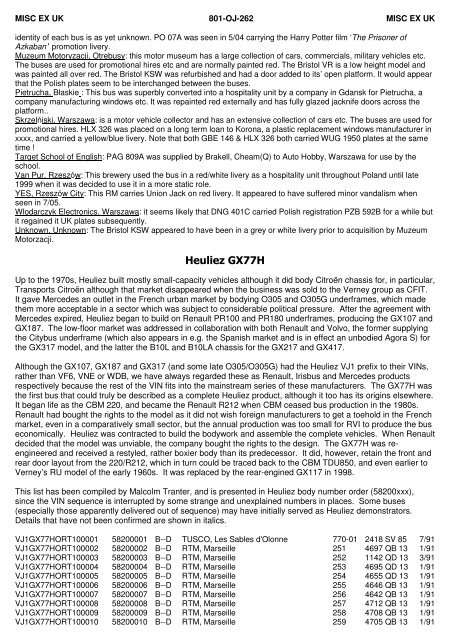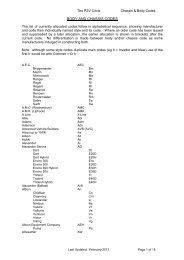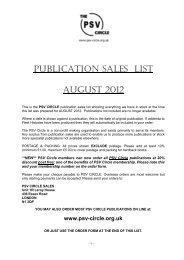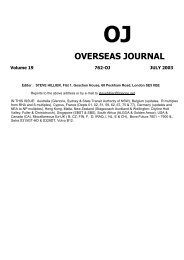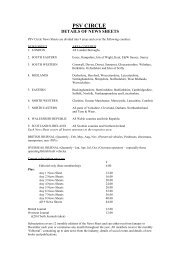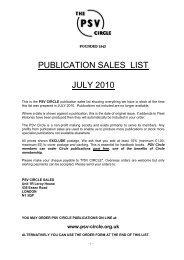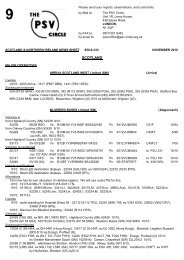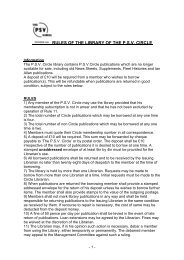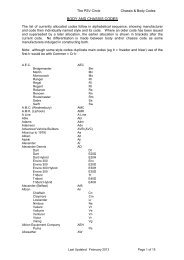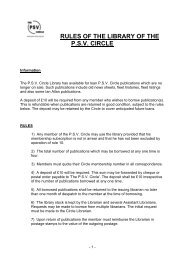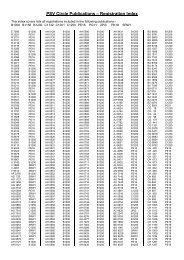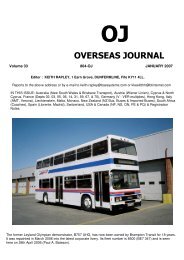oj overseas journal - The PSV Circle Website
oj overseas journal - The PSV Circle Website
oj overseas journal - The PSV Circle Website
Create successful ePaper yourself
Turn your PDF publications into a flip-book with our unique Google optimized e-Paper software.
MISC EX UK 801-OJ-262 MISC EX UK<br />
identity of each bus is as yet unknown. PO 07A was seen in 5/04 carrying the Harry Potter film ‘<strong>The</strong> Prisoner of<br />
Azkaban’’ promotion livery.<br />
Muzeum Motoryzacji, Otrebusy: this motor museum has a large collection of cars, commercials, military vehicles etc.<br />
<strong>The</strong> buses are used for promotional hires etc and are normally painted red. <strong>The</strong> Bristol VR is a low height model and<br />
was painted all over red. <strong>The</strong> Bristol KSW was refurbished and had a door added to its’ open platform. It would appear<br />
that the Polish plates seem to be interchanged between the buses.<br />
Pietrucha, Błaskie : This bus was superbly converted into a hospitality unit by a company in Gdansk for Pietrucha, a<br />
company manufacturing windows etc. It was repainted red externally and has fully glazed jacknife doors across the<br />
platform..<br />
Skrzelńiski, Warszawa: is a motor vehicle collector and has an extensive collection of cars etc. <strong>The</strong> buses are used for<br />
promotional hires. HLX 326 was placed on a long term loan to Korona, a plastic replacement windows manufacturer in<br />
xxxx, and carried a yellow/blue livery. Note that both GBE 146 & HLX 326 both carried WUG 1950 plates at the same<br />
time !<br />
Target School of English: PAG 809A was supplied by Brakell, Cheam(Q) to Auto Hobby, Warszawa for use by the<br />
school.<br />
Van Pur, Rzeszów: This brewery used the bus in a red/white livery as a hospitality unit throughout Poland until late<br />
1999 when it was decided to use it in a more static role.<br />
YES, Rzeszów City: This RM carries Union Jack on red livery. It appeared to have suffered minor vandalism when<br />
seen in 7/05.<br />
Wlodarczyk Electronics, Warszawa: it seems likely that DNG 401C carried Polish registration PZB 592B for a while but<br />
it regained it UK plates subsequently.<br />
Unknown. Unknown: <strong>The</strong> Bristol KSW appeared to have been in a grey or white livery prior to acquisition by Muzeum<br />
Motorzacji.<br />
Heuliez GX77H<br />
Up to the 1970s, Heuliez built mostly small-capacity vehicles although it did body Citroën chassis for, in particular,<br />
Transports Citroën although that market disappeared when the business was sold to the Verney group as CFIT.<br />
It gave Mercedes an outlet in the French urban market by bodying O305 and O305G underframes, which made<br />
them more acceptable in a sector which was subject to considerable political pressure. After the agreement with<br />
Mercedes expired, Heuliez began to build on Renault PR100 and PR180 underframes, producing the GX107 and<br />
GX187. <strong>The</strong> low-floor market was addressed in collaboration with both Renault and Volvo, the former supplying<br />
the Citybus underframe (which also appears in e.g. the Spanish market and is in effect an unbodied Agora S) for<br />
the GX317 model, and the latter the B10L and B10LA chassis for the GX217 and GX417.<br />
Although the GX107, GX187 and GX317 (and some late O305/O305G) had the Heuliez VJ1 prefix to their VINs,<br />
rather than VF6, VNE or WDB, we have always regarded these as Renault, Irisbus and Mercedes products<br />
respectively because the rest of the VIN fits into the mainstream series of these manufacturers. <strong>The</strong> GX77H was<br />
the first bus that could truly be described as a complete Heuliez product, although it too has its origins elsewhere.<br />
It began life as the CBM 220, and became the Renault R212 when CBM ceased bus production in the 1980s.<br />
Renault had bought the rights to the model as it did not wish foreign manufacturers to get a toehold in the French<br />
market, even in a comparatively small sector, but the annual production was too small for RVI to produce the bus<br />
economically. Heuliez was contracted to build the bodywork and assemble the complete vehicles. When Renault<br />
decided that the model was unviable, the company bought the rights to the design. <strong>The</strong> GX77H was reengineered<br />
and received a restyled, rather boxier body than its predecessor. It did, however, retain the front and<br />
rear door layout from the 220/R212, which in turn could be traced back to the CBM TDU850, and even earlier to<br />
Verney’s RU model of the early 1960s. It was replaced by the rear-engined GX117 in 1998.<br />
This list has been compiled by Malcolm Tranter, and is presented in Heuliez body number order (58200xxx),<br />
since the VIN sequence is interrupted by some strange and unexplained numbers in places. Some buses<br />
(especially those apparently delivered out of sequence) may have initially served as Heuliez demonstrators.<br />
Details that have not been confirmed are shown in italics.<br />
VJ1GX77HORT100001 58200001 B--D TUSCO, Les Sables d'Olonne 770-01 2418 SV 85 7/91<br />
VJ1GX77HORT100002 58200002 B--D RTM, Marseille 251 4697 QB 13 1/91<br />
VJ1GX77HORT100003 58200003 B--D RTM, Marseille 252 1142 QD 13 3/91<br />
VJ1GX77HORT100004 58200004 B--D RTM, Marseille 253 4695 QD 13 1/91<br />
VJ1GX77HORT100005 58200005 B--D RTM, Marseille 254 4655 QD 13 1/91<br />
VJ1GX77HORT100006 58200006 B--D RTM, Marseille 255 4646 QB 13 1/91<br />
VJ1GX77HORT100007 58200007 B--D RTM, Marseille 256 4642 QB 13 1/91<br />
VJ1GX77HORT100008 58200008 B--D RTM, Marseille 257 4712 QB 13 1/91<br />
VJ1GX77HORT100009 58200009 B--D RTM, Marseille 258 4708 QB 13 1/91<br />
VJ1GX77HORT100010 58200010 B--D RTM, Marseille 259 4705 QB 13 1/91


